Intel’s Push to Enthusiasts: Soldered CPUs and 6.9 GHz Overclocks
by Ian Cutress on October 11, 2018 1:45 PM EST- Posted in
- CPUs
- Intel
- Overclocking
- LN2
- Core 9th Gen
- Z390
- Liquid Nitrogen
- Core i9-9900K
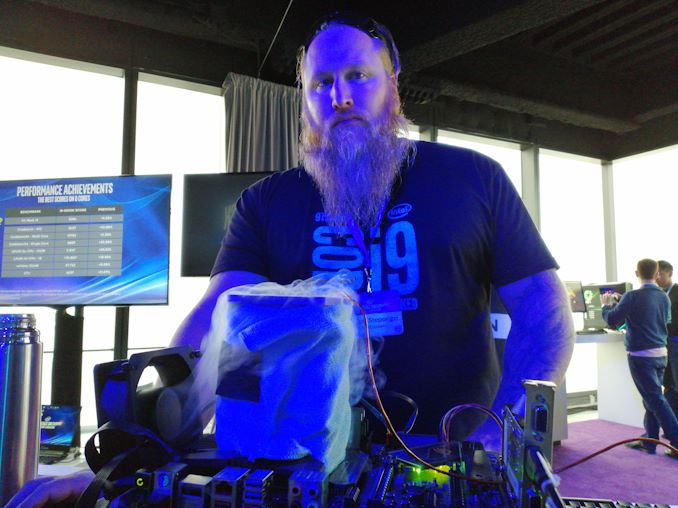
One of the prominent parts of Intel’s announcement this week for the new 9th Generation core processors was that both the overclockable consumer processors and the new high-end desktop processors all feature a soldered thermal interface material (STIM) between the silicon die and the heatspreader. This is a vast improvement over the previous thermal interface material due to the solder's superior ability to conduct thermal energy away from the silicon die. As part of the announcement, Intel also engaged in some extreme overclocking at its launch event using Liquid Nitrogen as an effective coolant, and some overclocking world champions.
Choosing A Thermal Interface Material (TIM)
With the desktop processors we use today, they are built from a silicon die (the smart bit), a package substrate (the green bit), a heatspreader (the silver bit), and a material that helps transfer heat from the silicon die to the heatspreader. The quality of the binding between the silicon die and the heatspreader using this thermal interface material is a key component in the processors ability to remove the heat generated from using it.
Traditionally there are two different types of thermal material: a heat conductive paste, or a bonded metal. Both have positives and negatives.
The heat conductive paste is a universal tool – it can be applied to practically any manufactured processor, and is able to deal with a wide range of changing conditions. Because metals expand under temperature, when a processor is used and gets hot, it expands – so does the heatspreader. The paste can easily deal with this. This allows paste-based processors to live longer and in more environments. Using a bonded metal typically reduces the level of thermal cycling possible, as the metal also expands and contracts in a non-fluid way. This might mean the processors has a rated lifespan of several years, rather than a dozen years. However, the bonded metal solution performs a lot, lot better – metal conducts heat better than the silicon-based pastes – but it is slightly more expensive (a dollar or two per unit, at most, when the materials and manufacturing are taken into account).
| Thermal Interface | |||||||
| Intel | |||||||
| Intel | Celeron | Pentium | Core i3 | Core i5 | Core i7 Core i9 |
HEDT | |
| Sandy Bridge | LGA1155 | Paste | Paste | Paste | Bonded | Bonded | Bonded |
| Ivy Bridge | LGA1155 | Paste | Paste | Paste | Paste | Paste | Bonded |
| Haswell / DK | LGA1150 | Paste | Paste | Paste | Paste | Paste | Bonded |
| Broadwell | LGA1150 | Paste | Paste | Paste | Paste | Paste | Bonded |
| Skylake | LGA1151 | Paste | Paste | Paste | Paste | Paste | Paste |
| Kaby Lake | LGA1151 | Paste | Paste | Paste | Paste | Paste | - |
| Coffee Lake | 1151 v2 | Paste | Paste | Paste | Paste | Paste | - |
| CFL-R | 1151 v2 | ? | ? | ? | K = Bonded | - | |
| AMD | |||||||
| Zambezi | AM3+ | Bonded | Carrizo | AM4 | Bonded | ||
| Vishera | AM3+ | Bonded | Bristol R | AM4 | Bonded | ||
| Llano | FM1 | Paste | Summit R | AM4 | Bonded | ||
| Trinity | FM2 | Paste | Raven R | AM4 | Paste | ||
| Richland | FM2 | Paste | Pinnacle | AM4 | Bonded | ||
| Kaveri | FM2+ | Paste / Bonded* | TR | TR4 | Bonded | ||
| Carrizo | FM2+ | Paste | TR2 | TR4 | Bonded | ||
| Kabini | AM1 | Paste | |||||
| *Some Kaveri Refresh were bonded | |||||||
In our Ryzen APU delidding article, we went through the process of removing the heatspreader and conductive paste from a popular low cost product, and we showed that replacing that paste with a bonded liquid metal improved temperatures, overclocking, and performance in mid-range overclocks. If any company wants to make enthusiasts happy, using a bonded metal is the way to go.
Intel on Enthusiasts
For several years, Intel has always stated that they are there for enthusiasts. In the distant past, as the table above shows, Intel provided processors with a soldered bonded metal interface and was happy to do so. In recent times however, the whole product line was pushed into the heat conductive paste for a number of reasons.

Slide for Intel's 4th Gen, which used paste
As Intel was continually saying that they still cared about enthusiasts, a number of users were concerned that Intel was getting itself confused. Some believed that Intel had ‘enthusiasts’ and ‘overclockers’ in two distinct non-overlapping categories. It is what it is, but now Intel has returned to using applying STIM and wants to court overclockers again.
Pushing Frequencies with Liquid Nitrogen
I should be safe in saying that most AnandTech readers understand that in order to push an overclock, bigger and better cooling is required. This might mean a good air cooler, water cooling, or if you want an exotic daily system, chilled water. The idea here is that as the voltage and frequency is raised, more exotic cooling is required to keep the system from overheating. Beyond chilled water, there are a bunch of enthusiasts that use sub-zero coolants.
Competitive overclocking is an industry to which I am relatively intimate: I have at some point in my existence hit #2 in the world rankings, albeit briefly. The nature of the extreme overclocking scene has changed from very motivated enthusiasts and engineers to vendor backed individuals with thousands of dollars in hardware trying to get the very highest frequency, or break particular benchmark world records. It comes down to experience, preparation, and a good amount of luck to get the best hardware and the best results in the world.
For example, the high-frequency world record on an AMD processor is 8794.33 MHz, using a FX-8350 under liquid nitrogen, whereas the Intel record is 8532.17 MHz on a Celeron 352. Each processor runs differently when you get down to -196C, and some of the older processors were better at pushing the envelope. But while newer processors might not clock as high, the additional cores and raw per-MHz performance help push the benchmarking part of the world records higher.
So while a good air overclock on a high-end gaming processor like the Core i7-8086K is around 5.4 GHz, under liquid nitrogen Intel’s hired guns on the day were pushing 6.9 GHz with the latest 9th generation Core i9-9900K on all cores, and reaching 7.1 GHz internally, with up to 7.4 GHz on a single core. Given that the chip is new, there are usually a good couple of months of learning a new platform and chip binning to push it as high as the previous generation, so we’re likely to see higher over the coming months.
The two overclockers hired by Intel, known in the community as Splave and Steponz, were happily breaking records for 8-core processors left right and center for various CPU focused tests. They also achieved at least one ‘global’ world record, beating every other processor that has ever existed, in PCMark 10.
For a few other tests, Intel achieved some best ever 8-core results.
What’s the point?
Not everyone is going to run liquid nitrogen on their system. Not only is the cooling setup a disaster to maintain 24/7, as well as expensive, the inherent instability in the system at this frequency and the tuning required isn’t practical as it requires constant tweaking. Extreme overclocking is often compared to drag racing – to see who can go the quickest quarter mile. There are several parallels – going for the highest frequency might be just a peak speed contest, while running a complex benchmark is more akin to Formula 1. There are users that have been competitive overclocking for decades, and for a select few, it has become a career that has ended up with motherboards that offer new features that everyone who wants to can use. Sure, it isn’t as useful as taking a family saloon to the shops, but it is fun to watch them go.
Related Reading
- Overclocking The AMD Ryzen APUs: Guide and Results
- The Intel Skylake i7-6700K Overclocking Performance Mini-Test to 4.8 GHz
- AMD Ryzen 5 2400G and Ryzen 3 2200G Integrated Graphics Frequency Scaling
- Delidding The AMD Ryzen 5 2400G APU: How To Guide and Results
- EVGA Roboclocker: A Water Cooling Loop for LIQUID NITROGEN
- GIGABYTE’s Liquid Nitrogen Memory Overclocking Motherboard, Z97X-SOC Force LN2
- Thermal Interface and Extreme Overclocking on the Core i7-8086K (with Alva Jonathan)



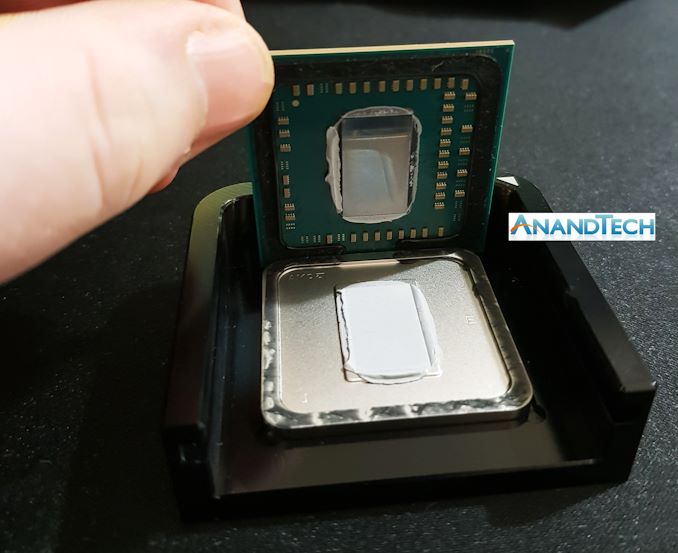
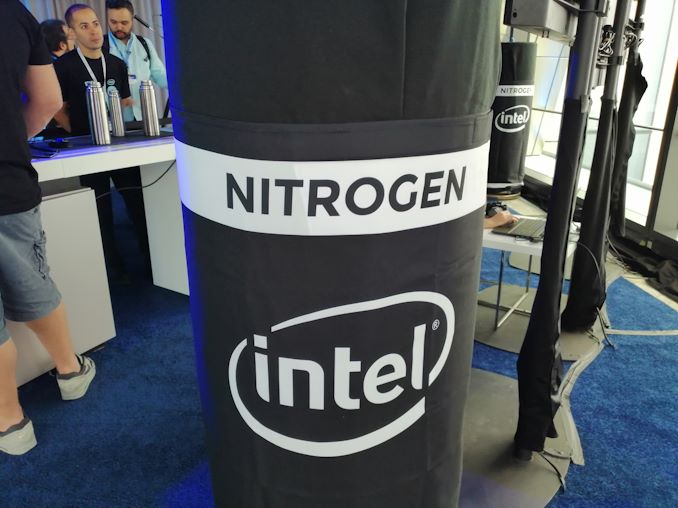
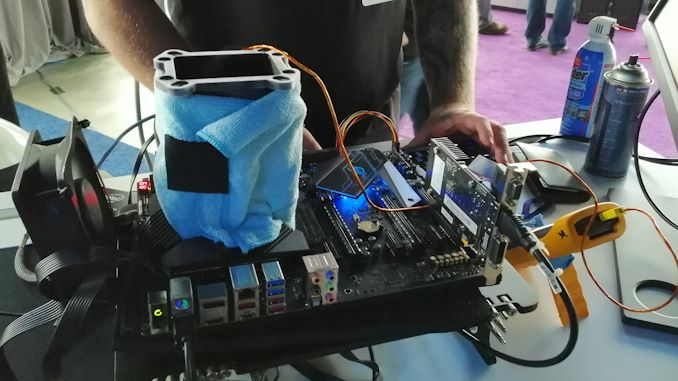
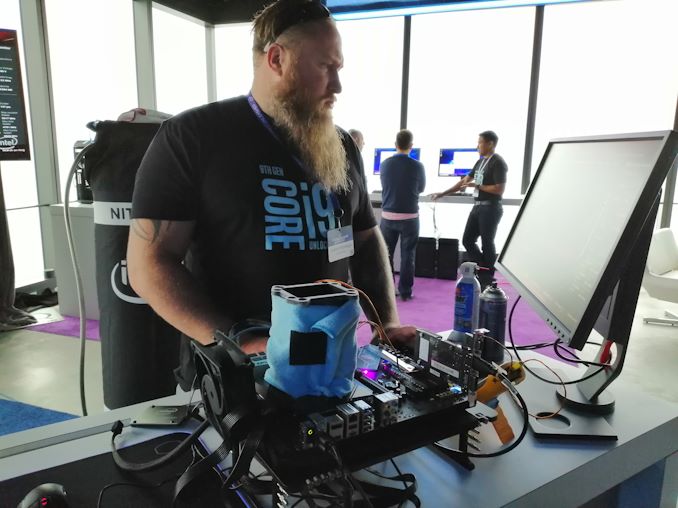
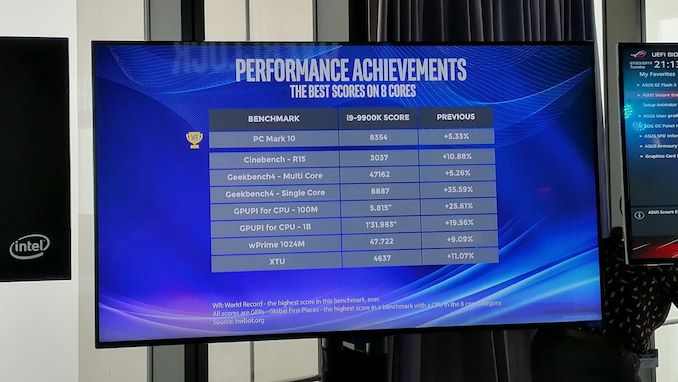








54 Comments
View All Comments
PeachNCream - Monday, October 15, 2018 - link
An image uploaded on Apr 16 2016 and posted as relevant to a discussion happening in October 2018 alongside an accusation of me being "full of it." How does this random, 2+ year old screen capture of CPU and GPU from an old laptop support any claim you've made?I currently play on a couple of different private servers. Vanilla with Insta max level is hard to find. The majority are TBC+ that fall under the private "fun server" class and few of them have the sort of population necessary to support endgame content raids regularly. Jumping on one with an old laptop you claim to still own in order to test raid performance to make your point in a discussion post will likely require an existing private account backed up by a lot of hours of grinding. Given the stale upload date of the image you shared, I'm suspicious that you don't have as much supporting evidence as you say you do. If that laptop hardware really is yours, how exactly were you overclocking it? Most laptop motherboards lacked the necessary settings to enable overclocking and the cooling headroom required and that includes the Toshiba Satellite 1950 in the (two year old) screencap you've linked.
Although I won't claim to have access to my old Northwood P4, I do have clear memories of how it performed and that it was reasonable in WoW without an overclock. At the time, there was very little mention of overclocking among the population. The bottom line is that overclocking just isn't as widespread as you claim - though I will concede that Zingam percentage estimate is an exaggeration, but it's clear that exaggeration was Zing's intent to begin with so there's no use in splitting hairs about it.
imanuglyone - Tuesday, October 16, 2018 - link
I had a P4 with HT and a dual core Athlon 64x2 4200 system back in those days when i was running vanilla and while i preferred to play on the AMD system. The P4 was functional with lower settings. Just my anecdotal 2 penniesskavi - Friday, October 12, 2018 - link
why do you disable turbo? that's one of the biggest parts of making normal activities feel fast.Achaios - Saturday, October 13, 2018 - link
Because when I am using MS Office, Adobe Acrobat and Firefox, which is what I do on the PC 90% of time, I really do not care if these open 0.1 of a second faster with turbo on.RU482 - Saturday, October 13, 2018 - link
still...why bother?Targon - Friday, October 12, 2018 - link
There is overclocking, and then extreme overclocking(what is being talked about here). Liquid Nitrogen is not used for your typical overclocking. Now, the only reason it means anything is to compare, "the very best that can be done" on a given platform. The theory is that if these new chips can hit a peak overclock that is much higher than what can be done on an AMD based platform, then they still have an edge in terms of design, even if that does not make it down to typical usage.For overclocking though, I expect that over 25 percent of those who build their own systems will overclock at least a little. Cranking a first generation Ryzen chip to 3.9GHz isn't pushing the limits, but will give a bit better performance. Pushing an Intel chip to 4.9GHz on all cores all the time would obviously give better performance than stock speeds. Even a .2GHz overclock will be better than no overclock, and will probably not result in ANY instability or additional fan noise.
Those going full open loop liquid will be a smaller percentage of the overall market, but these days, a closed loop CPU cooler isn't all that uncommon, and won't cost too much more than a high end air cooler.
Santoval - Friday, October 12, 2018 - link
Er, 100% - 0.00000001% is 99.99999999%, not 99.0000009%. Neither number is anywhere close to reality anyway. They might apply to LN2 and/or liquid helium overclocking, but certainly not air-cooling or liquid-cooling overclocking.skavi - Friday, October 12, 2018 - link
what about the 0.99999909% of users?twtech - Tuesday, October 16, 2018 - link
Actually I would say quite a few people OC their systems. Moderate OCs that don't require a VCore increase and aren't running the chip overly hot don't really harm the CPU and can be maintained in a stable state for years.LN2 OCing on the other hand? Sure, your numbers are pretty much correct there. It's basically the equivalent of top-fuel drag racing for CPUs.
JoeyJoJo123 - Thursday, October 11, 2018 - link
I saw GN's coverage with Steponz. Cool dude, it's nice to hear solder is officially back (at least for these enthusiast parts) and I would be fine if they only used STIM, for example, on K-branded SKUs for the overclockers and save a few pennies on the non-K SKUs by sticking to their thermal paste.9900k sounds like a beast, and while solder makes the product tempting, the $500 cost and the potential 10nm node drop in the next year or two makes it more compelling to "wait and see". I'm glad AMD's pushed Intel towards higher core counts and back to solder in the mean time, even if so far it hasn't resulted in lower prices for blue team CPUs.